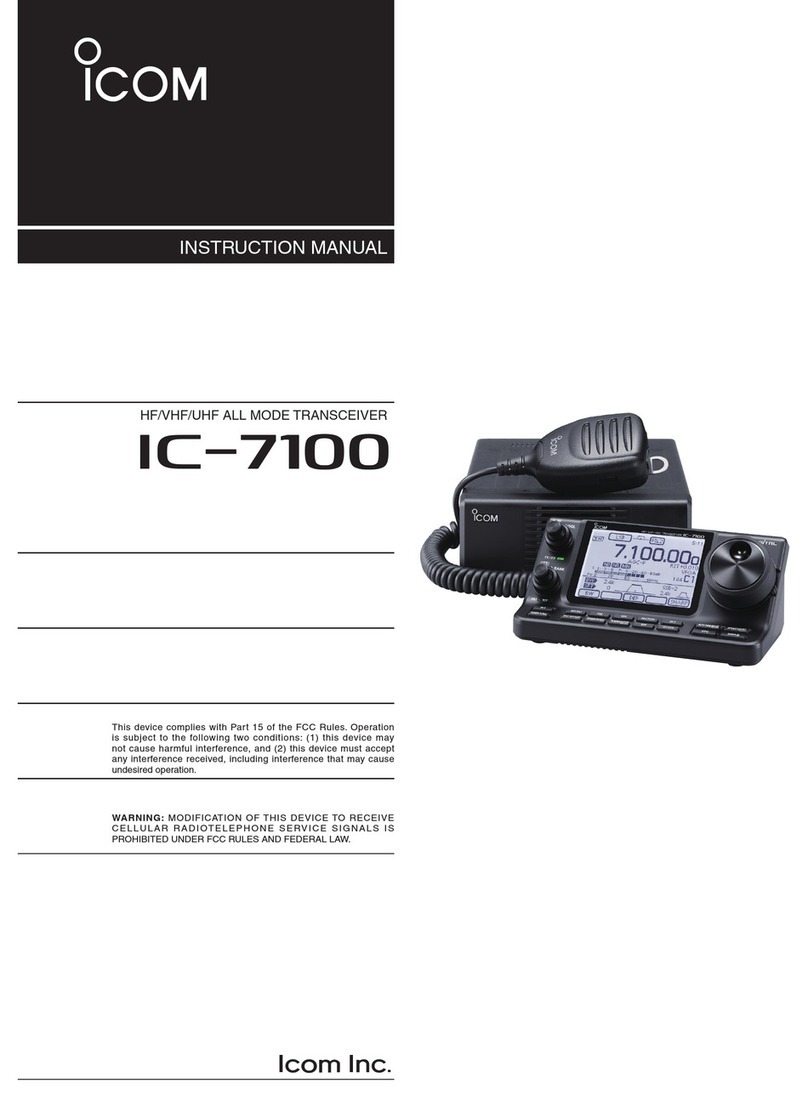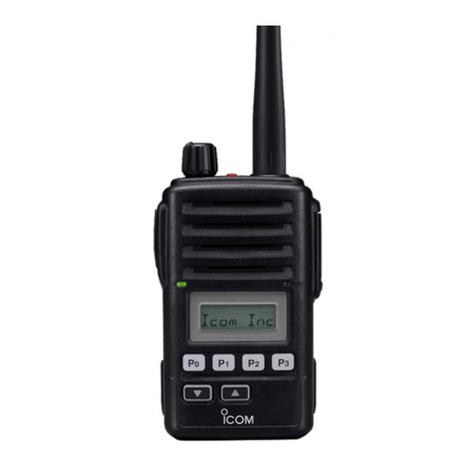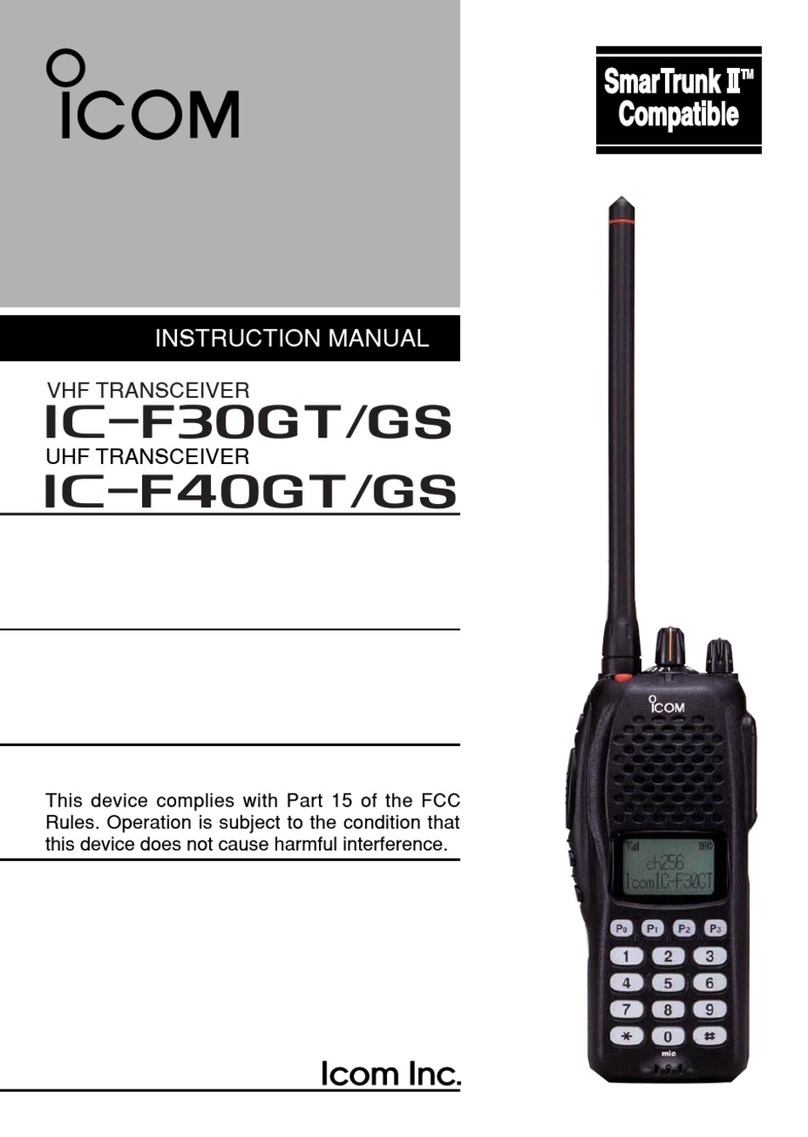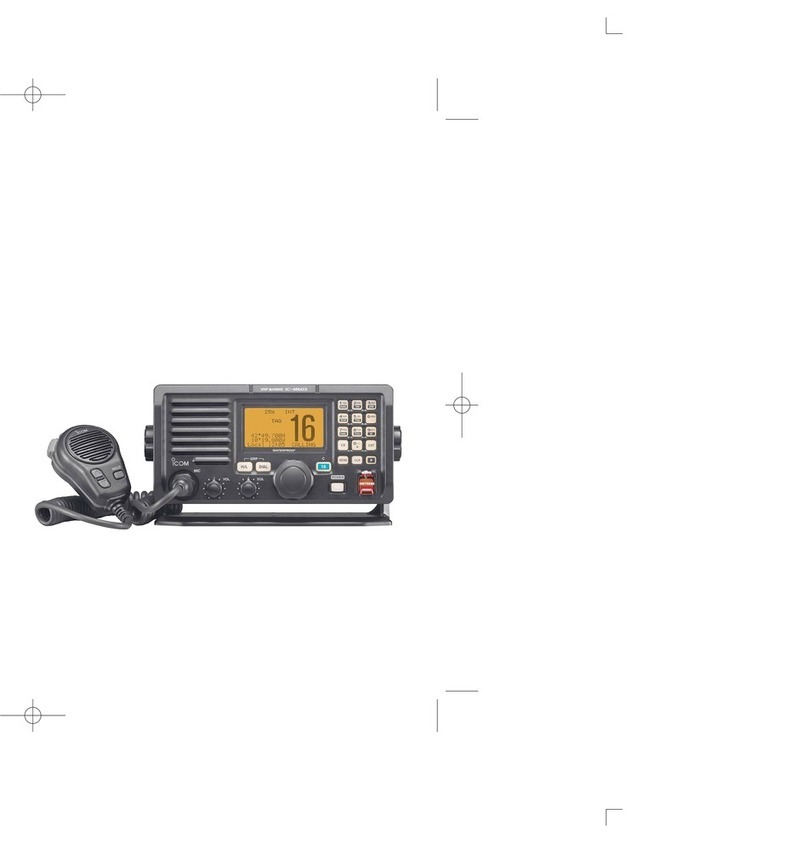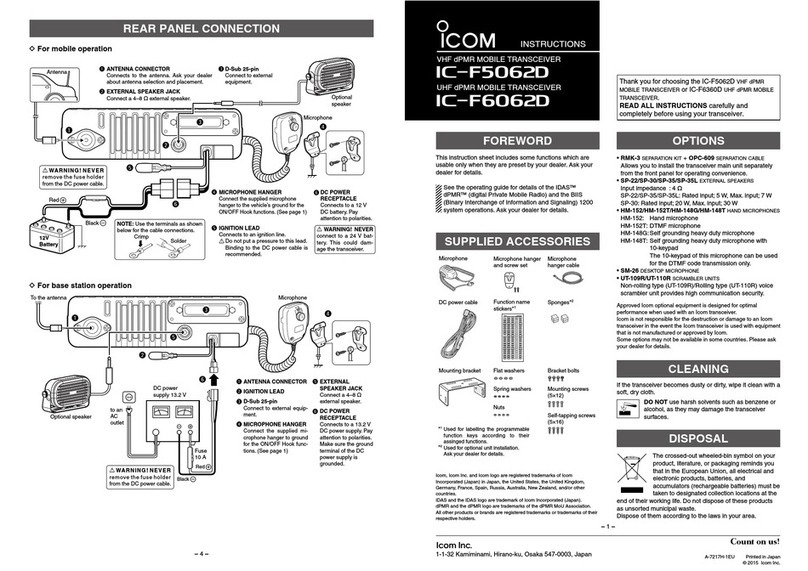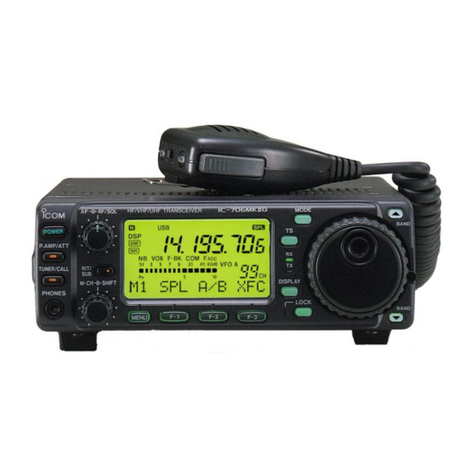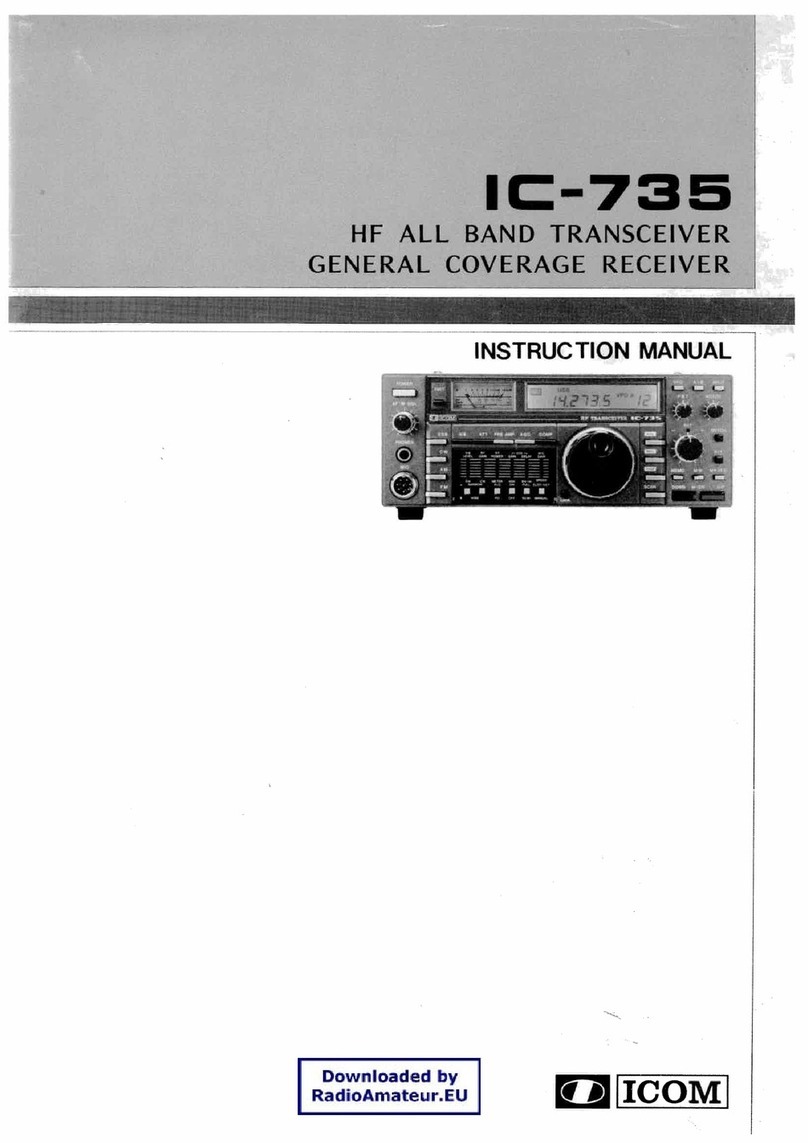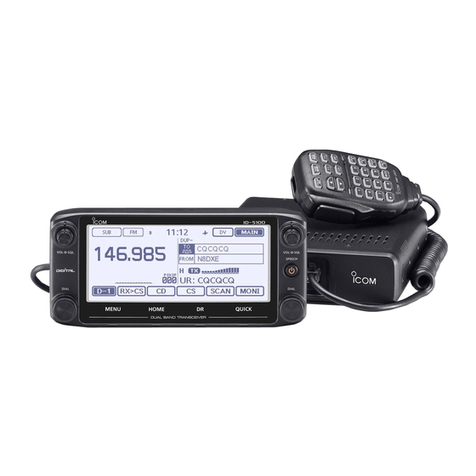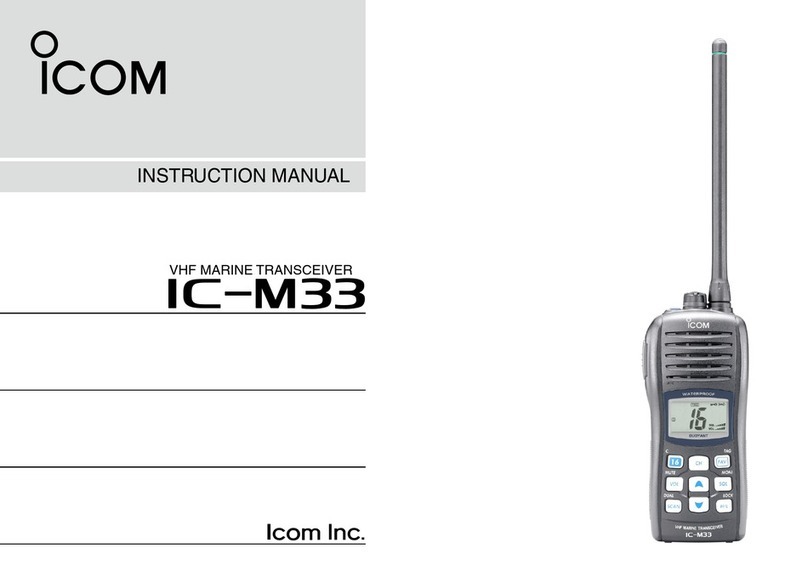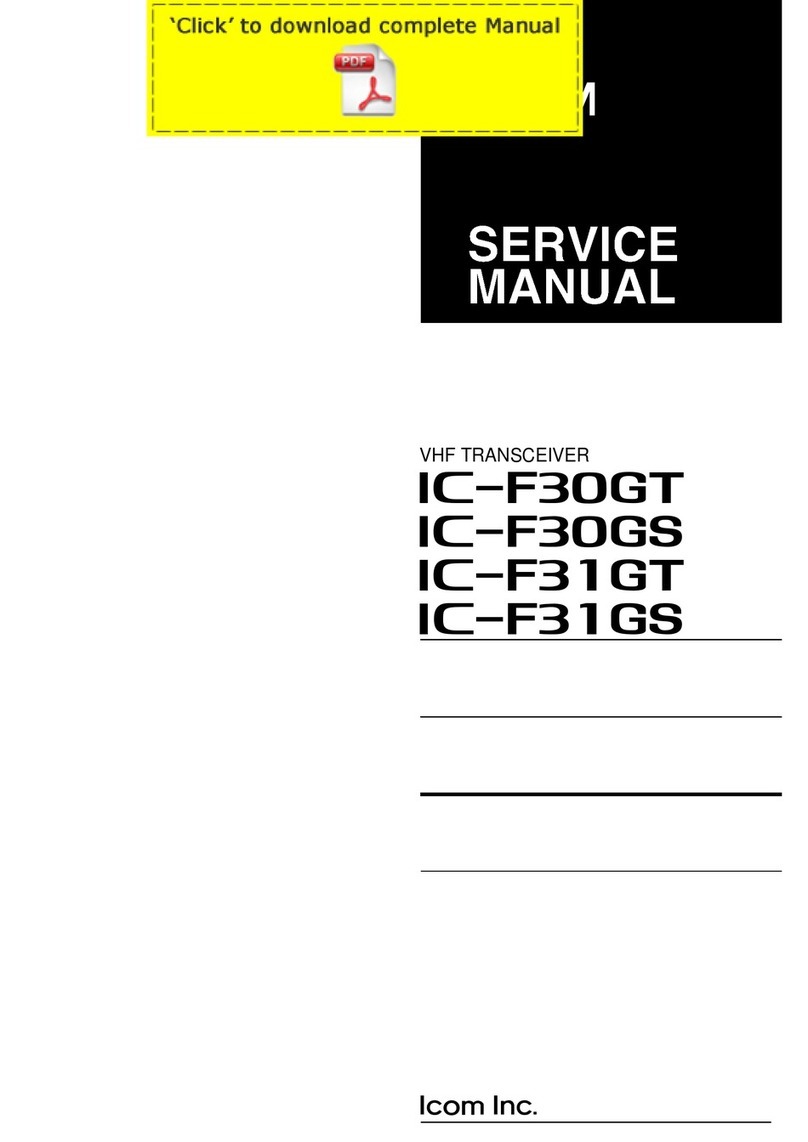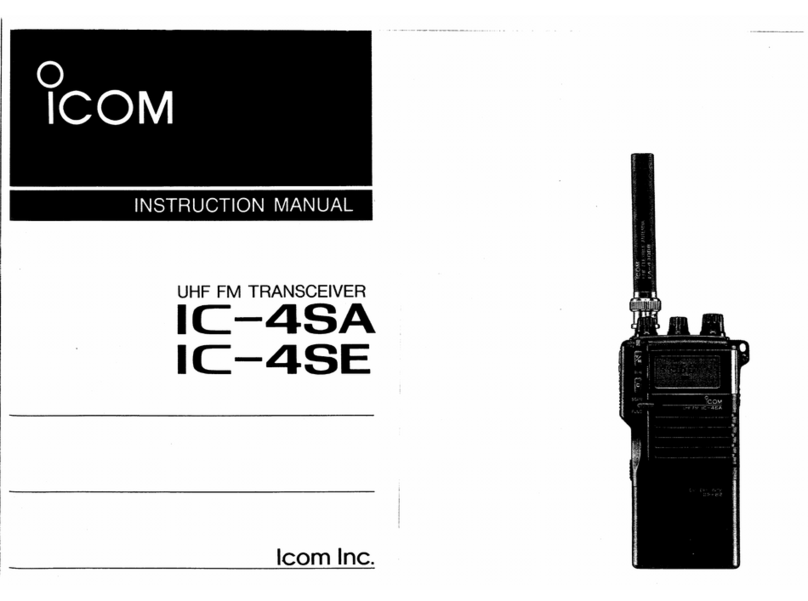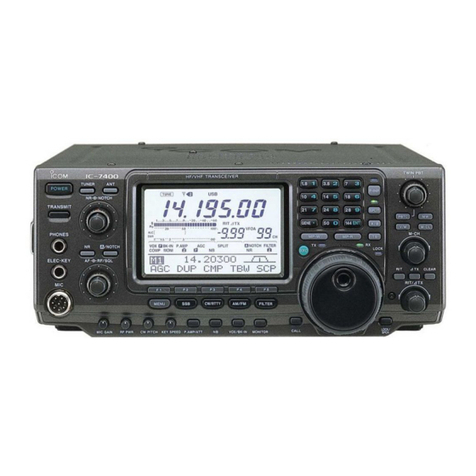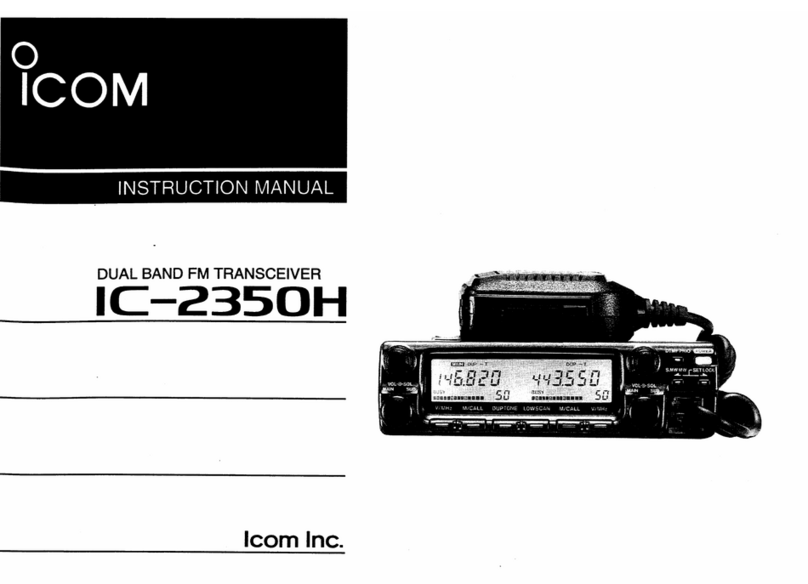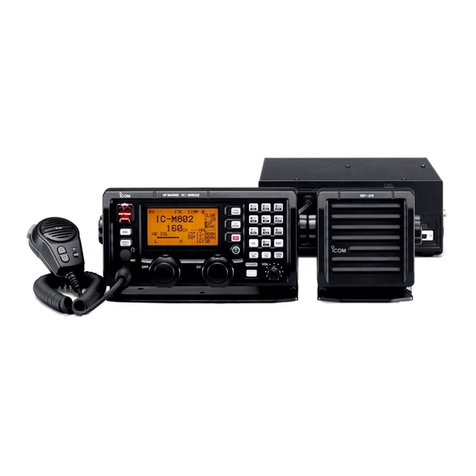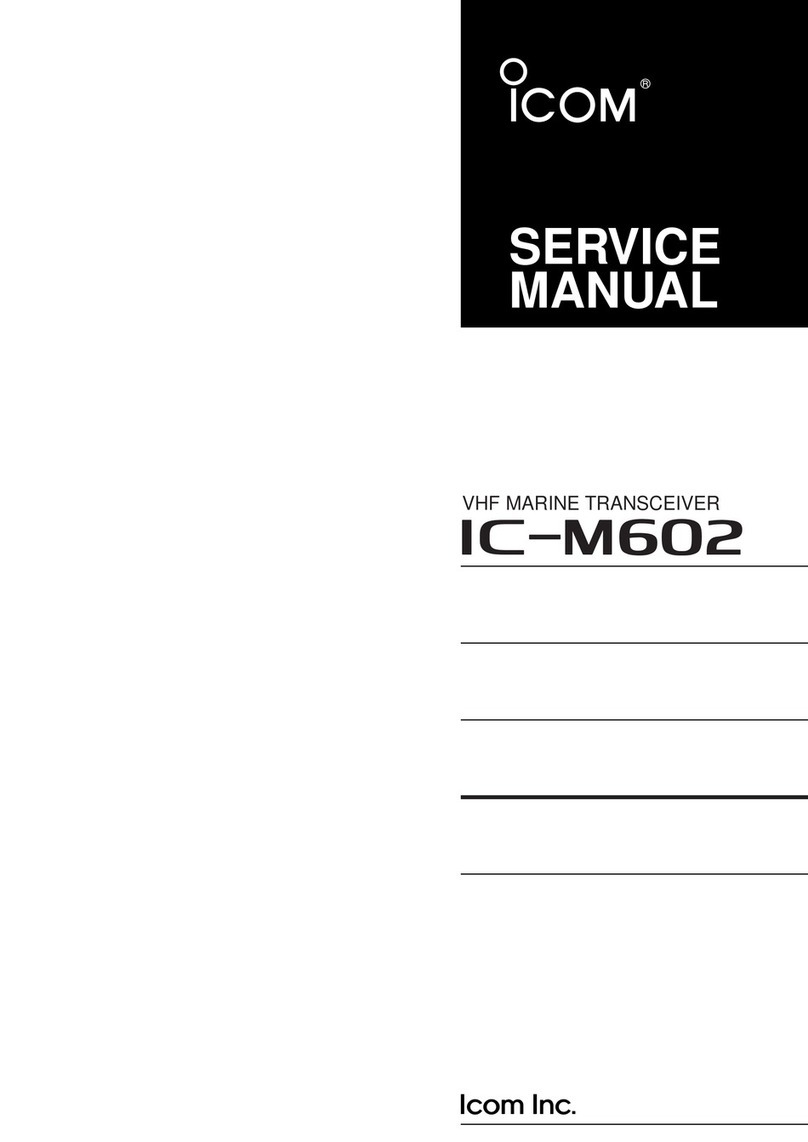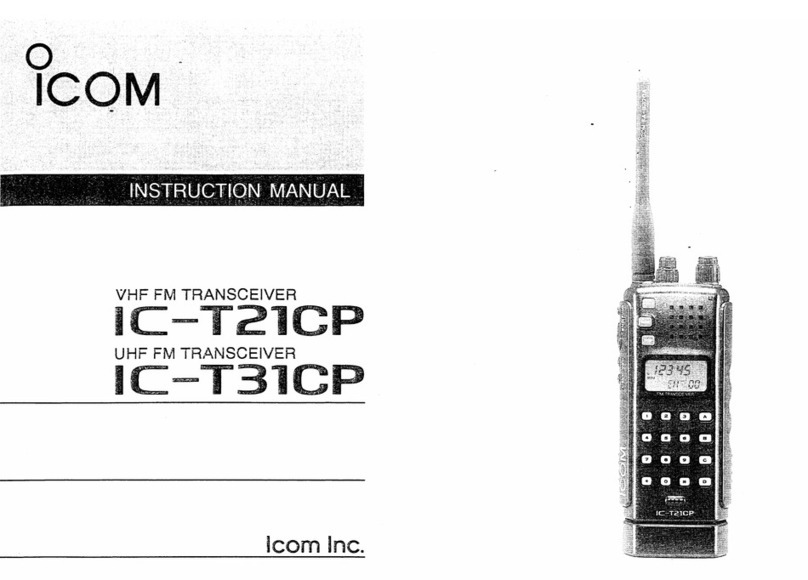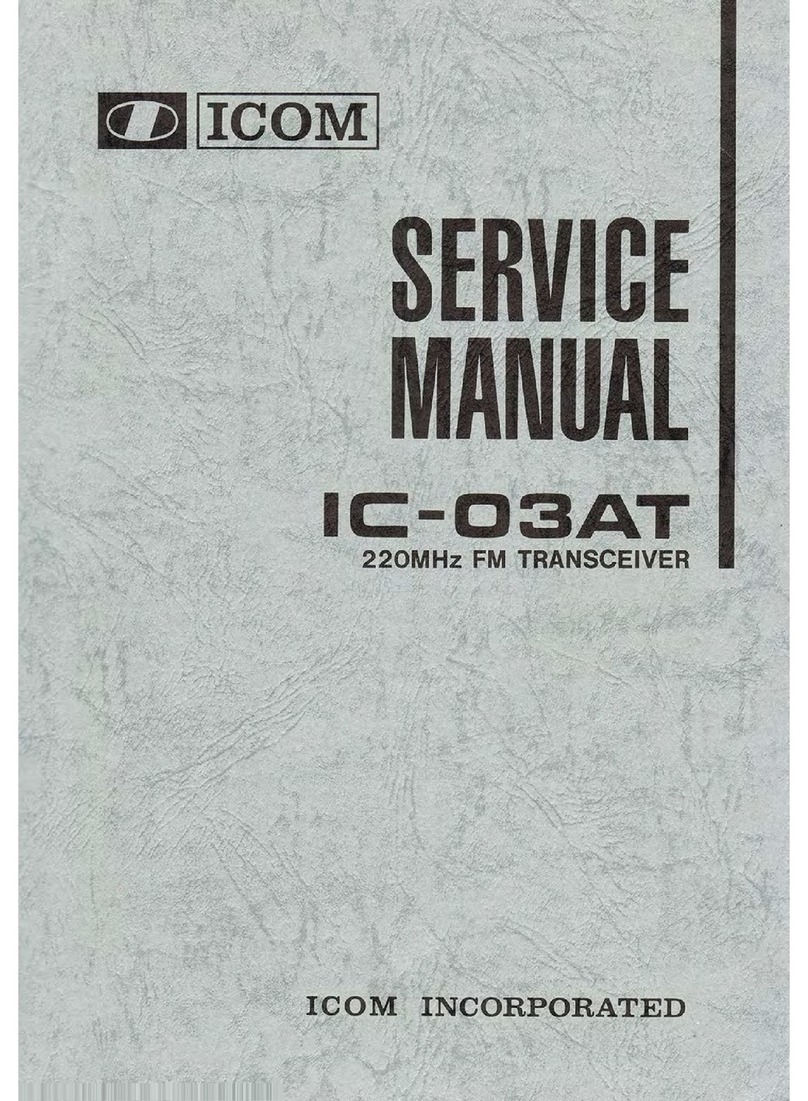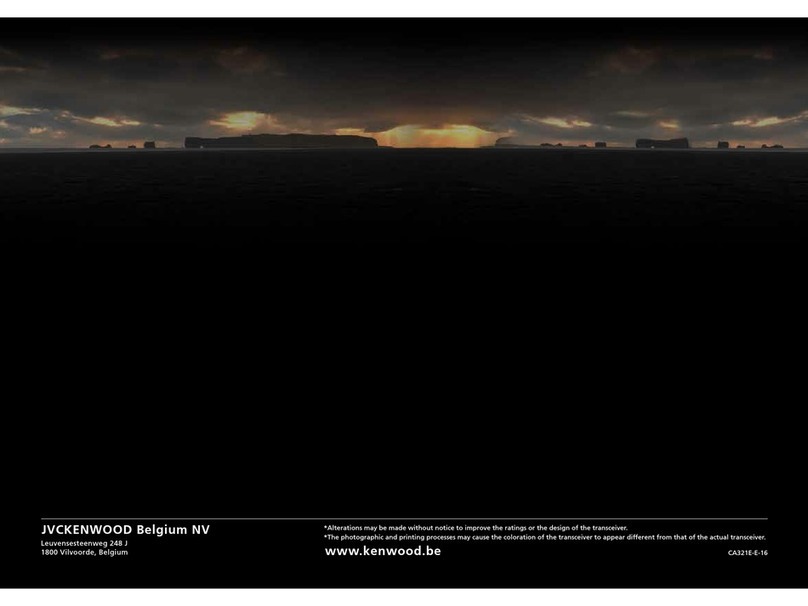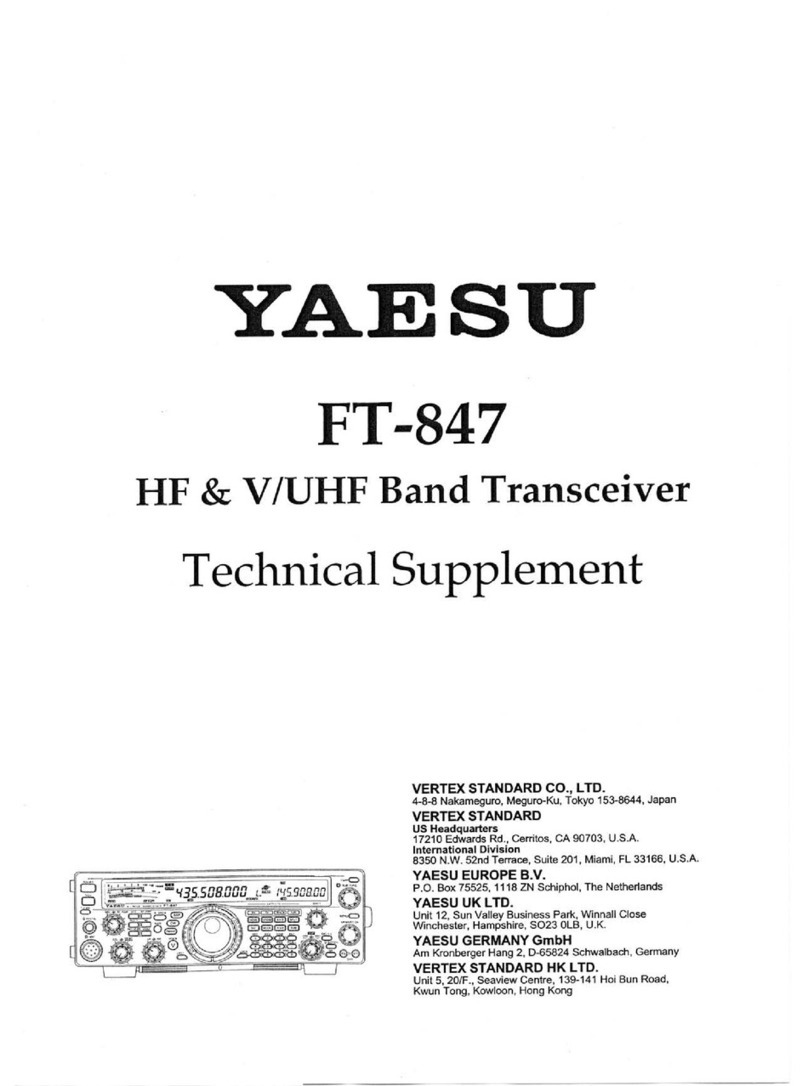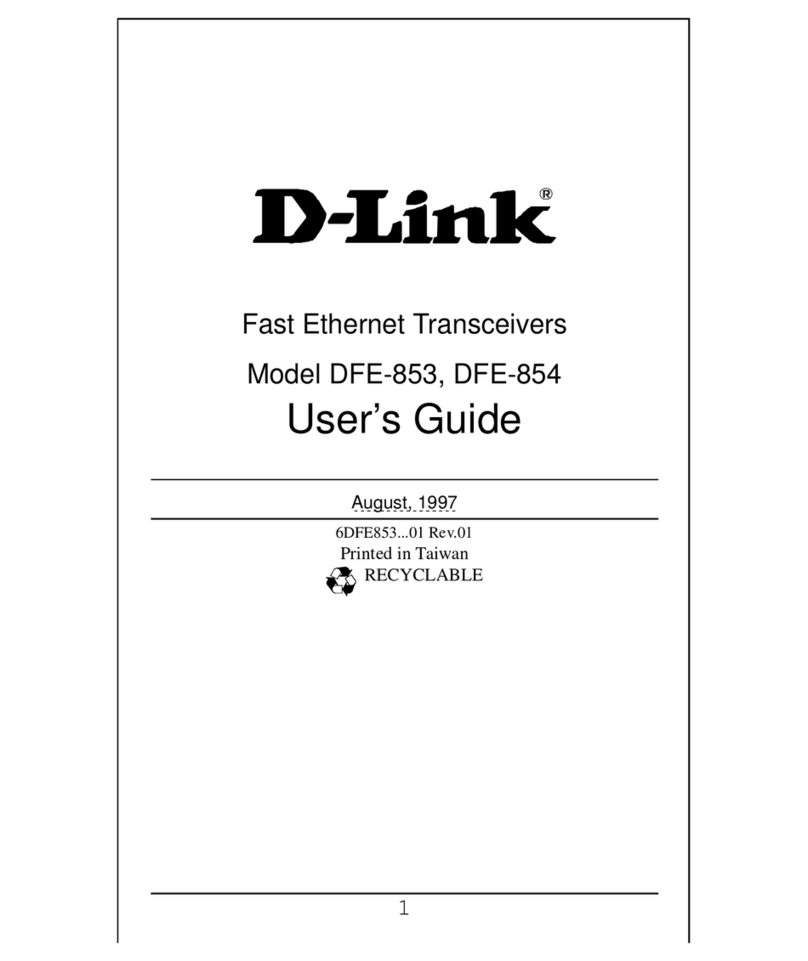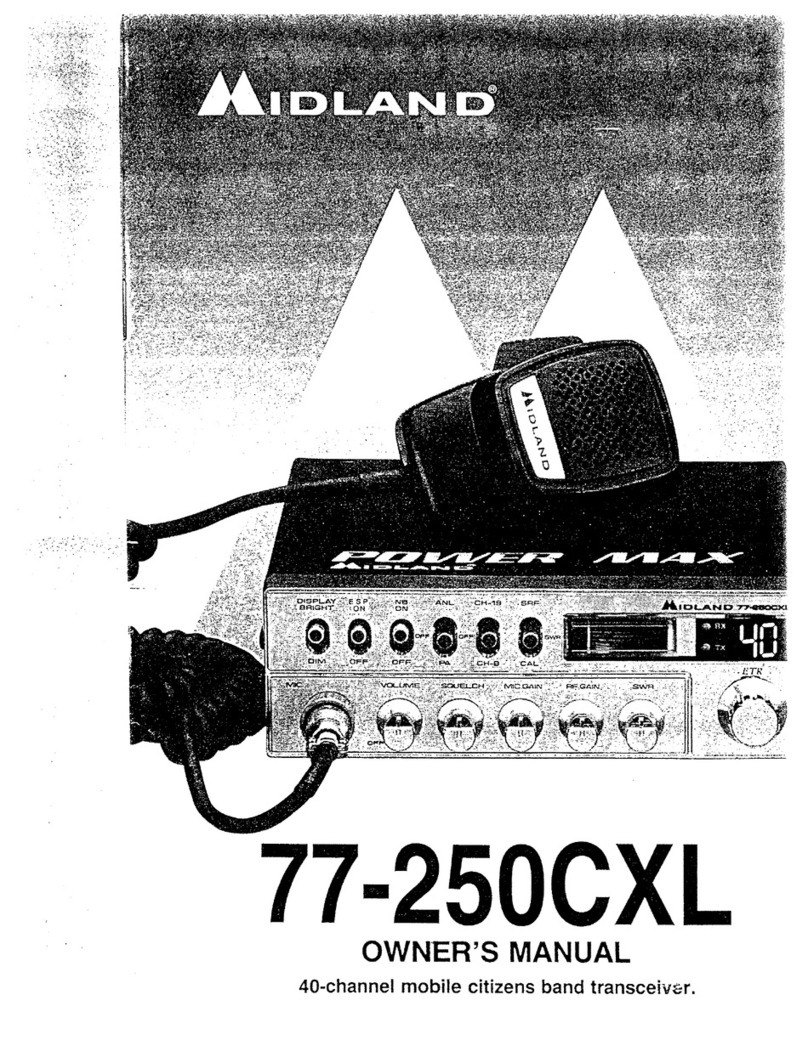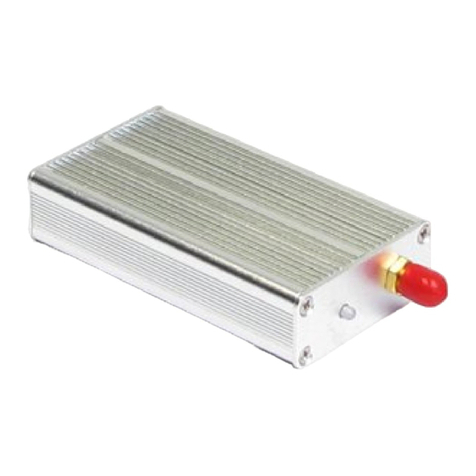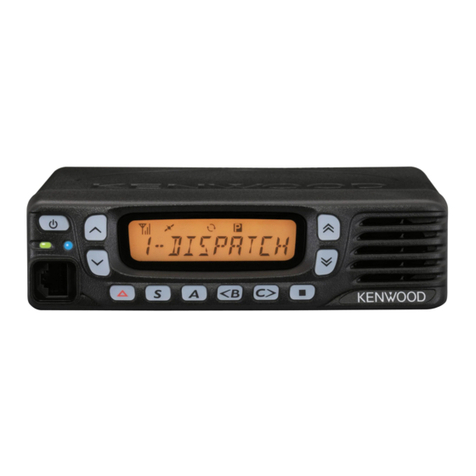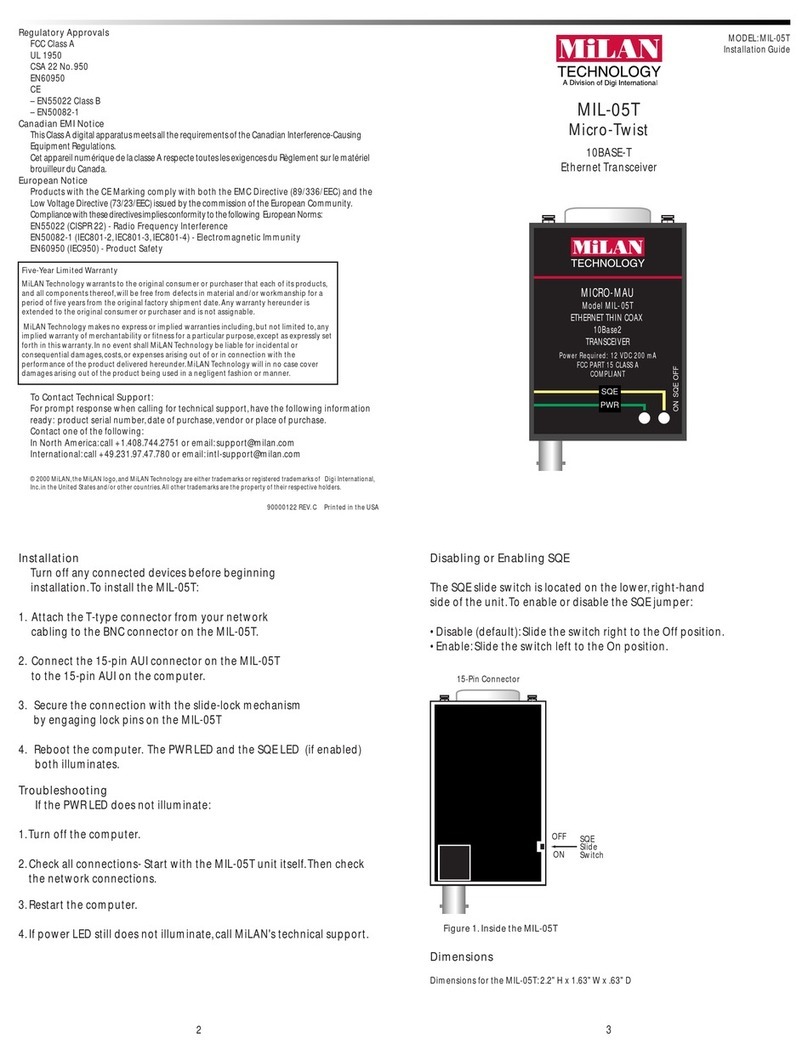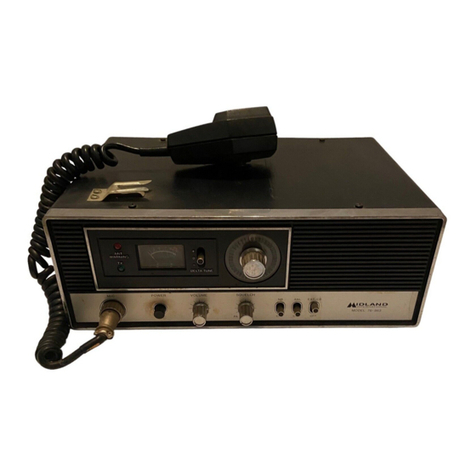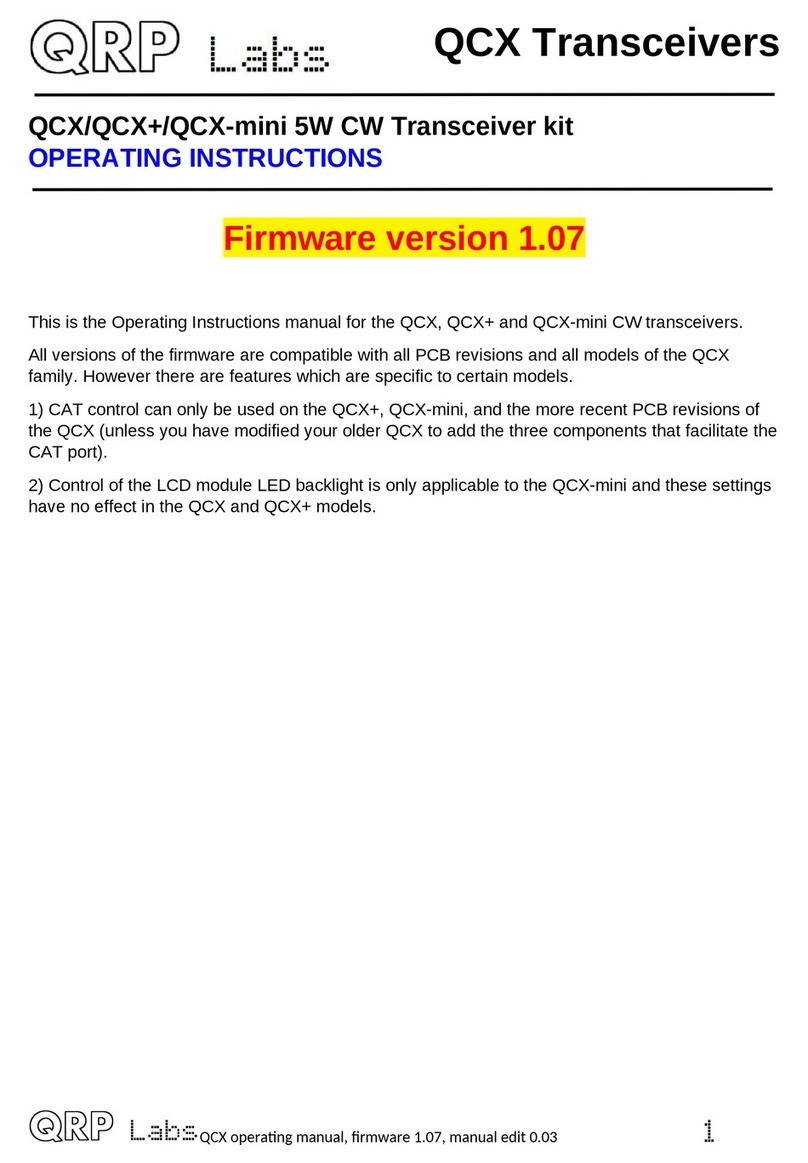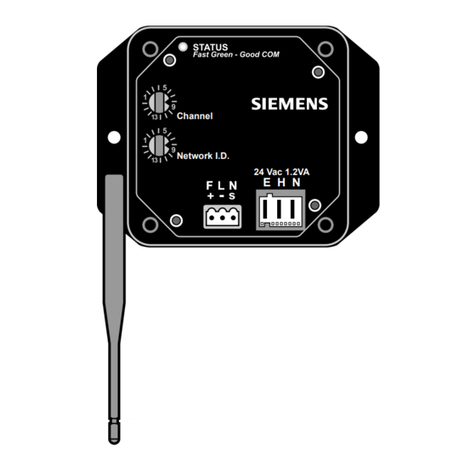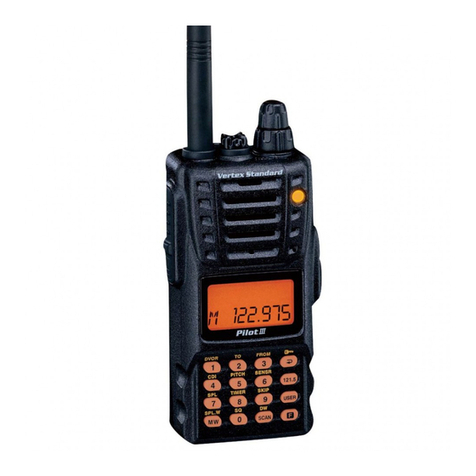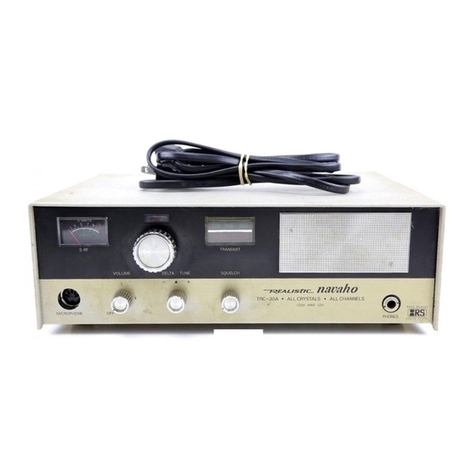Icom IC-F6012 User manual

S-14716XZ-C1
Mar. 2011
UHF MOBILE TRANSCEIVERS

This service manual describes the latest technical
information for the IC-F6011, IC-F6012, IC-F6013,
IC-F6013H UHF MOBILE TRANSCEIVERS, at the time of
publication.
NEVER connect the transceiver to an AC outlet or to a DC
power supply that uses more than the specified voltage.
This will ruin the transceiver.
DO NOT expose the transceiver to rain, snow or any liquids.
DO NOT reverse the polarities of the power supply when
connecting the transceiver.
DO NOT apply an RF signal of more than 20 dBm (100 mW) to
the antenna connector. This could damage the transceiver’s
front-end.
To upgrade quality, any electrical or mechanical parts
and internal circuits are subject to change without notice
or obligation.
MODEL VERSION
CHANNEL
SPACING
(kHz)
FREQUENCY
RANGE
IC-F6011 USA-01 12.5/25.0 400−470 MHz
USA-02 450−512 MHz
IC-F6012 EUR-02 12.5/20.0/25.0
400−470 MHzIC-F6013 EXP-01
12.5/25.0
IC-F6013H EXP-03
EXP-04 450−520 MHz
Be sure to include the following four points when ordering
replacement parts:
1. 10-digit Icom part number
2. Component name
3. Equipment model name and unit name
4. Quantity required
<ORDER EXAMPLE>
1110007320 S.IC NJM2591V IC-F6011 MAIN-A UNIT 5 pieces
8820001210 Screw 2438 screw IC-F6011 Top cover 10 pieces
Addresses are provided on the inside back cover for your
convenience.
ORDERING PARTS
1. Make sure that the problem is internal before
disassembling the transceiver.
2. DO NOT open the transceiver until the transceiver is
disconnected from its power source.
3. DO NOT force any of the variable components. Turn
them slowly and smoothly.
4. DO NOT short any circuits or electronic parts. An
insulated tuning tool MUST be used for all adjustments.
5. DO NOT keep power ON for a long time when the
transceiver is defective.
6. DO NOT transmit power into a Standard Signal
Generator or a Sweep Generator.
7. ALWAYS connect a 50 dB to 60 dB attenuator between
the transceiver and a Deviation Meter or Spectrum
Analyzer, when using such test equipment.
8. READ the instructions of the test equipment throughly
before connecting it to the transceiver.
REPAIR NOTES
INTRODUCTION CAUTION
Icom, Icom Inc. and the Icom logo are registered trademarks of Icom Incorporated (Japan) in Japan, the United States, the
United Kingdom, Germany, France, Spain, Russia and/or other countries.

TABLE OF CONTENTS
SECTION 1 SPECIFICATIONS
SECTION 2 INSIDE VIEWS
SECTION 3 DISASSEMBLY INSTRUCTION
SECTION 4 OPTIONAL PRODUCTS INSTALLATION
SECTION 5 CIRCUIT DESCRIPITON
5-1 RECEIVER CIRCUITS. . . . . . . . . . . . . . . . . . . . . . . . . . . . . . . . . . . . . . . . . . . . . . . . . . . . . . . . 5-1
5-2 TRANSMITTER CIRCUITS . . . . . . . . . . . . . . . . . . . . . . . . . . . . . . . . . . . . . . . . . . . . . . . . . . . . 5-3
5-3 FREQUENCY SYNTHESIZER CIRCUITS . . . . . . . . . . . . . . . . . . . . . . . . . . . . . . . . . . . . . . . . 5-4
5-4 VOLTAGE DIAGRAMS. . . . . . . . . . . . . . . . . . . . . . . . . . . . . . . . . . . . . . . . . . . . . . . . . . . . . . . . 5-4
5-5 PORT ALLOCATIONS . . . . . . . . . . . . . . . . . . . . . . . . . . . . . . . . . . . . . . . . . . . . . . . . . . . . . . . . 5-5
SECTION 6 ADJUSTMENT PROCEDURES
6-1 PREPARATION . . . . . . . . . . . . . . . . . . . . . . . . . . . . . . . . . . . . . . . . . . . . . . . . . . . . . . . . . . . . . 6-1
6-2 FREQUENCY ADJUSTMENT . . . . . . . . . . . . . . . . . . . . . . . . . . . . . . . . . . . . . . . . . . . . . . . . . . 6-4
6-3 TRANSMIT ADJUSTMENT . . . . . . . . . . . . . . . . . . . . . . . . . . . . . . . . . . . . . . . . . . . . . . . . . . . . 6-5
6-4 RECEIVE ADJUSTMENT . . . . . . . . . . . . . . . . . . . . . . . . . . . . . . . . . . . . . . . . . . . . . . . . . . . . . 6-6
SECTION 7 PARTS LIST
SECTION 8 MECHANICAL PARTS
SECTION 9 BOARD LAYOUTS
SECTION 10 BLOCK DIAGRAM
SECTION 11 VOLTAGE DIAGRAM

1 - 1
SECTION 1
.
SPECIFICATIONS
[USA], [EXP] [EUR]
GENERAL
• Frequency coverage 400–470 MHz
[USA-01], [EXP-01], [EXP-03]
450–520 MHz [EXP-04]
450–512 MHz [USA-02]
400–470 MHz
• Type of emission Wide 16K0F3E (25.0 kHz)
Middle – 14K0F3E (20.0 kHz)
Narrow 11K0F3E (12.5 kHz) 8K50F3E (12.5 kHz)
• Number of programable channels 8
• Antenna impedance 50 Ω(Nominal)
• Operating temperature range –30˚C to +60˚C (−22˚F to +140˚F) –25˚C to +55˚C
• Power supply requirement (Nominal) 13.6 V DC (Negative ground) 13.2 V DC (Negative ground)
• Current drain
(approx.) RX Stand-by 250 mA
Max.audio 700 mA
TX at 25 W 5.0 A
at 45 W* 11.0 A
• Dimensions
(projections not included)
[25 W ver.] 150 (W) × 40 (H) × 117.5 (D) mm; 5.91 (W) × 1.56 (H) × 4.63 (D) in
[45 W ver.] 150 (W) × 40 (H) × 167.5 (D) mm;
5.91 (W) × 1.56 (H) × 6.6 (D) in –
• Weight [25 W ver.] 0.8 kg (1.76 Ib)
[45 W ver.] 1.1 kg (2.43 Ib) –
TRANSMITTER
• Transmit output power [25 W ver.] 25 W (High), 10 W (Low2), 2.5 W (Low1)
[45 W ver.] 45 W (High), 25 W (Low2), 5.0 W (Low1) –
• Modulation Variable reactance frequency modulation
• Max. permissible deviation Wide ±5.0 kHz
Middle – ±4.0 kHz
Narrow ±2.5 kHz
• Frequency error ±2.5 ppm ±1.5 kHz
• Spurious emission 70 dB typ. 0.25 µW (≤1 GHz), 1.0 µW (>1 GHz)
• Adjacent channel power Wide 70 dB min.
Middle – 70 dB min.
Narrow 60 dB min.
• Audio frequency response +1 dB to –3 dB of 6 dB/octave (From 500–2500 Hz)
• Audio harmonic distortion 3% typ. (With 1 kHz AF 40% deviation)
• FM hum and noise
(Without CCITT filter)
Wide More than 40 dB (46 dB typ.) –
Narrow More than 34 dB (40 dB typ.) –
• Residual modulation
(With CCITT filter)
Wide – More than 45 dB (55 dB typ.)
Middle – More than 43 dB (53 dB typ.)
Narrow – More than 40 dB (50 dB typ.)
• Limiting charact of modulation 70–100% of max. deviation
• Microphone impedance 600 Ω
*; 45 W version only.

1 - 2
[USA], [EXP] [EUR]
RECEIVER
• Receive system Double-conversion superheterodyne
• Intermediate frequencies 1st IF; 46.35 MHz, 2nd IF; 450 kHz
• Sensitivity 0.25 μV typ. at 12 dB SINAD −4 dBμV (EMF) typ. at 20 dB SINAD
• Squelch sensitivity (At threshold) 0.25 μV typ. −4 dBμV (EMF) typ.
• Adjacent channel
selectivity
Wide More than 70 dB (75 dB typ.)
Middle − More than 70 dB (75 dB typ.)
Narrow More than 60 dB (65 dB typ.)
• Spurious response 70 dB min.
• Intermodulation More than 70 dB (75 dB typ.) More than 65 dB (67 dB typ.)
• FM hum and noise
(without CCITT filter)
Wide More than 40 dB (45 dB typ.) –
Narrow More than 34 dB (40 dB typ.) –
• Residual modulation
(with CCITT filter)
Wide – More than 45 dB (55 dB typ.)
Middle – More than 43 dB (53 dB typ.)
Narrow – More than 40 dB (50 dB typ.)
• Audio output power 4.0 W typ. (At 5% distortion with a 4 Ωload)
• Audio output impedance 4 Ω
Measurements made in accordance with TIA-603 ([USA], [EXP]) or EN 300 086 ([EUR]).
All stated specifications are subject to change without notice or obligation.

2 - 1
SECTION 2
.
INSIDE VIEWS
• FRONT UNIT
(TOP VIEW)
TX/RX INDICATOR LED DRIVERS
(Q13 and Q14)
CPU
(IC1)
RESET IC
(IC2)
EEPROM
(IC3)
TONE LPF
(IC5)
TONE FILTER SWITCH
(Q3)
CLOCK FREQUENCY
SHIFT DIODE
(D6)
KEY BACKLIGHT SW
(Q2)
KEY BACKLIGHT DRIVER
(Q1)

2 - 2
• MAIN-A/MAIN-B UNIT
(TOP VIEW)
CPU5V LINE REGULATOR
(IC10)
TONE FILTER
(Q39)
IF DEMODULATOR IC
(IC1)
1ST IF AMP
(Q4)
AF AMP
(IC21)
PLL IC
(IC4)
1ST IF FILTER
(Q4)
VCO SW
(Q15)
RIPPLE FILTER
(Q17)
APC AMP
(IC2)
2ND IF FILTER
BANDWIDTH SWITCH
(Q40)
+8V LINE REGULATOR
(IC9)
VCC LINE SW
(Q23)
R8 LINE REGULATOR
(Q26)

2 - 3
• MAIN-A/MAIN-B UNIT
(BOTTOM VIEW)
REFERENCE FREQUENCY
OSCILLATOR (X2)
AF AMP
(IC15)
VCO
AF/TONE FILTER
(IC16)
AF MUTE SWITCH
(Q35)
Ext. MODULATION
LINE SWITCH
(Q31)
REFERENCE OSCILLATOR
MODULATION BUFFER
(IC19)
D/A CONVERTER
(IC18)
EXPANDER
(IC17)
ANALOG SWITCH
(IC14)
D/A CONVERTER
(IC20)
DRIVE AMP
(Q8)
RF AMP
(Q2)
1ST MIXER
(Q3)
2ND IF FILTER
(For wide mode)
(FI2)
2ND IF FILTER
(For narrow mode)
(FI6)
+5V LINE REGULATOR
(Q27,Q28) T8 LINE REGULATOR
(Q25)

3 - 1
SECTION 3
.
DISASSEMBLY INSTRUCTION
1) Remove 4 screws from the bottom cover, and then
remove it.
2) Disconnect the flat cable and speaker cable.
3) Remove 2 screws from the both sides, and then remove
the front panel in the direction of the arrow.
4) Remove 9 screws from the PCB.
FLAT
CABLE
BOTTOM COVER
FRONT PANEL
SPEAKER
CABLE
UNSOLDER
Solder
remover
PCB
PCB
PCB
5) Unsolder total of 9 points; 3 points at the antenna
connector, 6 points at the PA module.
6) Remove the PCB from the CHASSIS.

4 - 1
SECTION 4 OPTIONAL PRODUCTS INSTALLATION
Install optional OPC-1939/OPC-2078 as follows:
1)
Turn OFF the power, and then disconnect the DC power cable.
2) Remove 4 screws, and then remove the bottom cover.
3) Install the cable as shown.
OPC-1939/OPC-2078
Cut off the bushing as in the illustration.
K
I
4) Cut or short the patterns as below. (For AF output)
6) Recover the bottom cover, screws and DC power cable.
NOTE: Be sure to recover the patterns when you remove the optional product. Otherwise no TX modulation or AF output is available.
Solder
remover
D
5) Short the pattern as below. (For modulation input)
Install optional UT-108R as follows:
1) Turn OFF the power, and then disconnect the DC cable.
2) Remove 4 screws, and then remove the bottom cover.
3) Install the unit as shown.
4) Recover the bottom cover, screws and DC power cable.
Install optional UT-109R or UT-110R as follows:
1) Turn OFF the power, and then disconnect the DC power
cable.
2) Remove 4 screws, and then remove the bottom cover.
3) Cut the pattern on the PCB at "MIC" and "DISC" as
showon.
4) Install the unit as shown.
5) Recover the bottom cover, screws and DC power cable.
MIC
DISC

5 - 1
SECTION 5
.
CIRCUIT DESCRIPTION
5-1 RECEIVER CIRCUITS
RF CIRCUITS (MAIN-A/-B UNIT)
RF signal from the antenna is passed through the LPF (as
the harmonic filter for transmitting) and antenna SW (D3,
D5, D7), and then applied to the RX BPF circuit.
The applied RX signal is passed through the 3-staged tuned
BPF (D4, D8) to remove unwanted out-of-band signals, and
amplified by the low-noise RF AMP (Q2), and then applied
to the 1st mixer (Q3) through another 3-staged tuned BPF
(D9, D10, D19).
Total of 5 stage BPFs are tuned to the RX frequency by the
tuning voltage “T1” and “T2” from the D/A converter (IC20),
to obtain required IMD characteristic.
• RF CIRCUITS
1ST IF CIRCUITS (MAIN-A/-B UNIT)
The RX signal from the BPF is mixed with the 1st LO signal
to be converted into the 46.35 MHz 1st IF signal.
The 1st LO signal is generated by the RX VCO (Q14, D33,
D52), and passed through the LO SW (D15) and attenuator,
and then applied to the 1st mixer (Q3)
The converted 1st IF signal is filtered by the crystal filter (FI1)
and amplified by the 1st IF AMP (Q4), then applied to the IF
demodulator IC (IC1).
• 1ST IF CIRCUITS
2ND IF AND DEMODULATOR CIRCUITS (MAIN-A/-B UNIT)
The amplified 1st IF signal is mixed with the 2nd LO signal
at the internal 2nd IF mixer of the IF demodulator IC (IC1),
to obtain the 450 kHz 2nd IF signal.
The 15.3 MHz signal generated by the reference oscillator
(X2) is passed through the filter AMP (Q34, L33, L35,
C305–C308) to extract the 45.9 MHz 3rd harmonic
component. The 45.9 MHz signal is then applied to the pin
2 of IF demodulator IC (IC1) as the 2nd LO signal.
The converted 2nd IF signal is output from the pin 3 of IF
demodulator IC (IC1), and filtered by the ceramic filters
(FI2 and FI6 for Narrow mode; FI2 only for Wide mode) to
remove unwanted out-of-band signals, and then applied to
the internal frequency-demodulator of IF demodulator IC
(IC1) from pin 5.
The demodulator is a quadrature type which uses X1 as the
phase shifter.
The frequency-demodulated AF signal is output from pin 9 to
AF circuits.
• 2ND IF AND DEMODULATORCIRCUITS
LPFLP F PWR
DET
D1,D11,D12
ANT
SW
D3,D5
BPF
D10
BPF
D19
BPF
D9
BPF
D4
BPF
D8
RF
AMP
Q2
AGC
Q1
Tuning voltage “T2”
To 1st IF circuits
Tuning voltage “T1”
450-520 MHz
400-470 MHz
RSSI
From the TX AMP
LO
SW
D14,D15
Q3
1st mixer
BPF
XTAL
FI1
IF
AMP
Q4
LPF
From RF circuits
To IF IC 46.35 MHz
1st LO signals
(353.65 MHz-423.65 MHz
403.65 MHz-473.65 MHz)
REF X2
AMP Q34
X1
BPF
BPF
CERAMIC
FI6
W/N
SW
Q5
BPF
CERAMIC
FI2
W/N
SW
D70,D71
W/N
SW
D68,D69
D/A
IF IC
From 1st IF circuits
IC1
IC18
NWC
15.3MHz
45.9MHz
DISC
SQIN
450kHz
To the AF circuits
NWC

5 - 2
AF CIRCUITS (MAIN-A/-B UNIT)
The demodulated AF signal from the IF demodulator IC (IC1)
is amplified by the AMP (IC21), filtered by the HPF (IC16),
and then passed through the AF line SW (IC14) and LPF
(IC16). The filtered AF signal is adjusted in level (=loudness)
by the D/A converter (IC18), and applied to the AF AMP
(IC15) through the AF line SW (IC14).
The amplified AF signal is applied to the AF power AMP (IC8)
and power-amplified to obtain AF output level.
The power-amplified AF signal is output from the external
speaker jack (J4) on the rear panel, or applied to the
internal speaker on the FRONT UNIT, through the external
speaker jack (J4).
• RX AF CIRCUITS
LPF
IC16
LPF
IC16
LPF
Q39
HPF
IC16
AF
AMP
IC15 AF
POWER
AMP
IC8
AMP
IC21
AF
MUTE
Q35,36,D29
Int. speaker
Ext. speaker jack
J4
ANALOG
SW
SDEC
To the CPU (FRONT UNIT: IC1)
CDEC
IC14
D/A
IC18
(2/5 TONE signals)
(TCSS/DTCS signals)
FRONT UNIT
AF ON
DISC
From the IF IC
DISC
DISC
VRAF TMONI
RXAF
SIGNALING (DECODING) (MAIN-A/-B UNIT)
Demodulated signal from the pin 9 of the IF demodulator
IC (IC1) is passed through the LPF to extract tone signals
contained in the demodulated signal.
2/5 tone signal is extracted by the LPF (IC16). CTCSS/
DTCS signals are extracted by the LPF (Q39).
These extracted tone signal is applied to the CPU (FRONT
UNIT: IC1) for decoding.

5 - 3
5-2 TRANSMITTER CIRCUITS
MIC AMPLIFIER (FRONT UNIT)
Audio signal from the connected microphone is applied to
the MIC AMP (IC5), through the microphone connector (J1).
The amplified MIC signal is applied to the MAIN-A/-B UNIT.
TX AF CIRCUITS (MAIN-A/-B UNIT)
The MIC signal from the FRONT UNIT is passed through
the D/A converter (as a MIC gain controller; IC18) for level
adjustment, and applied to the limiter AMP which is also
rolled to the pre-emphasis circuit (IC16).
• TX AF CIRCUITS
MIC MUTE SWITCH (MAIN-A/-B UNIT)
The pre-emphasized MIC signal is passed through the MIC
mute SW (IC14).
While receiving or transmitting DTMF, 2/5 tone and BIIS
signals, the MIC mute SW (IC14) cuts the MIC line off, and
is controlled by “MMUT” signal from the expander (IC17).
SPLATTER FILTER (MAIN-A/-B UNIT)
The MIC signal from the MIC mute SW (IC14) is applied to
the splatter filter (IC16).
The splatter filter (IC16) is also used as the AF Summing
AMP for tone signal modulation (CTCSS, 2/5 TONE).
MODULATION CIRCUIT (MAIN-A/-B UNIT)
MIC signal from the splatter filter (IC16) is level-adjusted
(=deviation adjustment) by the D/A converter (IC18), and
applied to the TX VCO (Q13, D16, D18), through the
modulation mute SW (IC14) as the modulation signal.
The MIC signal is also applied to the reference frequency
oscillator (X2) as the modulation signal, through D/A
converter (IC18) and REF AMP (IC19).
• MODULATION CIRCUITS
CTCSS/DTCS SIGNALS ENCODING (FRONT UNIT)
The CTCSS/DTCS encoding signal from the CPU (IC1)
“CENC0–CENC2” is passed through the LPF (IC5) for
waveform conversion, and applied to the MAIN UNIT as tone
modulation signal.
2/5 TONE, DTMF ENCODING (FRONT UNIT)
Encoding signal from the CPU (IC1) named “SENC,” is
passed through the LPF (IC5), and applied to the MAIN
UNIT as tone modulation signal.
TX AMPLIFIERS (MAIN-A/-B UNIT)
The frequency-modulated signal from the TX VCO is buffer-
amplified by two buffers (Q11 and Q10), and applied to the
YGR AMP (Q9) as the TX signal through the LO SW (D14).
The TX signal is sequentially amplified by the YGR AMP
(Q9) and drive AMP (Q8). The amplified signal is applied
to the FET HPA module (IC3) through the LPF, and power-
amplified to obtain TX output power level.
The power-amplified TX signal is passed through the
antenna SW (D3) and LPF as a harmonic filter, and then fed
to the antenna.
APC CIRCUIT (MAIN-A/-B UNIT)
A portion of TX signal rectified by D1, D11 and D12 on
the TX line to detect TX power level. The rectified voltage
is applied to the APC AMP (IC2), and the APC AMP
controls the gain of drive AMP (Q8) and HPA module (IC3)
automatically by comparing the rectified voltage and the
power setting voltage "T1."
• TX AMPLIFIERS APC CIRCUIT
REF
OSC
X2
CR-794
TX/RX
SW
D14,D15
Q13,D16,31
FIL
LOOPPLL
IC
IC4
MB15A02
FM
MOD
D18
BUFF
Q10
BUFF
Q11
IC19
AMP
REF
TX VCO
BAL
15.3 MHz
From the D/A converter From the MIC line SW
To TX AMPs
LV
LPFLPF LP FLP F PWR
DET
D1,D11,D12
MUTE
SW
D28
ANT
SW
D3
PWR
AMP
IC
RX circuits
3
APC
AMP
IC2
DRIVE
AM
YGR
AMP P
Q8
Q9
T1 TMUT
From TX VCO
Splat.
IC16
AMP
IC16
AMP
IC5
MIC
line
SW
MIC
D/A
IC14
CD4066
IC18
MICROPHONE
CONNECTOR
J1
FRONT UNIT
MIC
BAL
To the Reference
frequency oscillator
MODI
MCOT
MCGO
TONE
CDTS
MODVRAF
TX VCO
SPIN

5 - 4
5-3 FREQUENCY SYNTHSIZER CIRCUITS
VCOs (MAIN-A/-B UNIT)
The TX VCO which generates the TX signal is composed
by Q13, D16, D18, L27, L38, etc., and the frequency
modulation is carried out by applying modulation signals to
D18.
The RX VCO which generates the 1st LO signals is
composed by Q14, D33, L39, etc.
These two VCOs are switched by the VCO SW (Q15, 16)
using “RXC” signal.
The output signal from each VCO is amplified by the buffer
AMP (Q11) and LO AMP (Q10), and then applied to the TX
or RX circuits.
A portion of generated signals is applied to the PLL IC (IC4)
via buffer AMP (Q12).
PLL (MAIN-A/-B UNIT)
The applied VCO output is divided according to the serial
data including divide ratio from the CPU, at the prescaler
and programmable divider. In the same way, the reference
frequency signal from the reference frequency signal
oscillator is applied to the PLL IC and divide so that these
are the same frequency.
The frequency-matched signal is applied to the phase
comparator and phase-compared. The resulted phase
difference is detected as a phase-type signal, and level-
adjusted at the charge pump then output. The output pulse
type signal is passed through the loop filter to be converted
into the DC voltage (=Lock Voltage).
Applying the lock voltage to the variable capacitors
(VD) which composes a part of the resonator of VCO,
the capacitance of VDs changes corresponding to the
applied lock voltage. This causes the change of resonation
frequency that determines the VCO oscillating frequency to
keep the VCO frequency constant.
When the oscillation frequency drifts, its phase changes
from that of the reference frequency, causing a lock voltage
change to compensate for the drift in the VCO oscillating
frequency.
• FREQUENCY SYNTHESIZER CIRCUITS
5-4 VOLTAGE DIAGRAM
Voltage from the power supply is routed to the whole of the transceiver via regulators and switches.
LPF
REF
X2
LO
SW
D14,D15
Q14,D33
Q13,D16
FIL
RIPPLE
Q17
VCO
SW
Q15,16
FIL
LOOPPLL
IC
IC4
X3
Q34
FM
MOD
D18
BPF
BUFF
Q10
BUFF
Q11
LPF
IC19
AMP
X2
Q12
BPF
TLV
ADJ
D53
RLV
ADJ
D52
IF IC
8V
RXC
RX VCO
TX VCO
IC1
REF 15.3MHz
Clock,Data,Strobe
45.9MHz
182.35 MHz-220.35 MHz
136/146 MHz-1740 MHz
TXC
T8V
RLVA
TLVA
LVLV
SW
POWER
Q23,Q24
+5
5V
REG
Q27,Q28
+8
REG
IC9
T8
REG
Q25,Q29,D23
W2
Power supply cable
REG
CPU5
IC10
Q26,Q30
R8
REG
Drive AMP(Q9), APC AMP(IC2), etc.
IF IC (IC1), PLL IC(IC4), etc.
RF AMP(Q2), 1st IF AMP(Q4), 1st mixer(Q3), etc.
External output(from J6)
VCOs, FRONT UNIT
T8V
R8V
8V
VCC
TMUT
RXC
PWON
HV
CPU5CPU5
VCC
8V
8V
8V
HPA module(IC3)
HV

5 - 5
• CPU (FRONT UNIT; IC1)
Pin
No.
Port
Name Description I/O
1−3 KR1−
KR3 Dealer-programmable keys input. I
10 CCS Chip-select signal to the attached optional unit. O
19−
21
CENC0−
CENC2 CTCSS/DTCS signal. O
23 DUSE
Frequency response of tone filter (IC5)
switching control.
“Low”=While transmitting.
O
24 IPTT PTT input.
“Low”=PTT is pushed. I
25 HANG Microphone on/off hook detect.
“Low”=The microphone is off hook. I
30 PLST
PLL strobe to the PLL IC (MAIN-A/-B UNIT; IC4,
pin 11).
O
34 ULCK
PLL unlock detect signal from the PLL IC
(MAIN
-A/-B
UNIT; IC4, pin 7).
“Low”=While the PLL circuit is unlocked.
I
35 LED1 Key indicator LED for [P1] (DS9) control.
“High”= Lights. O
36 LED2 Key indicator LED for [P2] (DS8) control.
“High”= Lights. O
37 LED3 Key indicator LED for [P3] (DS7) control.
“High”= Lights. O
28 POSW [PWR] key input.
“Low”=Pushed. I
39 DSDA Serial data to the D/A converter (MAIN
-A/-B
UNIT; IC20, pin 6). O
43 SENC DTMF signals to the LPF (IC5, pin 3). O
44 BEEP Beep audio. O
45 SDEC DTMF signals. I
46 CDEC CTCSS/DTCS signals. I
48 BATV Power supply voltage. I
49 LVIN VCO lock voltage. I
50 RSSI
Received signal strength level signal from the IF
demodulator IC (MAIN
-A/-B
UNIT; IC1, pin 12). I
51 TEMP Temperature sensing voltage. I
52 AFVI [VOL] dial (R14) input. (divided voltage of “5V”
line) I
59 RES CPU reset signal from the reset IC (IC8, pin 1).
“Low”=CPU is reset. I
69 CSFT CPU clock shift signal to the clock frequency
shift switch (D6). O
71 DAST Strobe signal to the D/A converter (MAIN
-A/-B
UNIT; IC18, pin 7). O
72 IGSW Ignition SW input. I
75 NOIS
Noise signal from the IF demodulate IC (
MAIN
-A/-B
UNIT;
IC1, pin 13). I
82 ESDA Serial data to the EEPROM (IC3, pin 5). O
85 ESCL Clock signal to the EEPROM (IC3, pin 6). O
86 PWON Transceiver's power control.
“High”=Power ON. I
87 CH4L Channel indicator LED for [CH4] (DS3) control.
“High”= Lights. O
88 CH3L Channel indicator LED for [CH3] (DS4) control.
“High”= Lights. O
89 CH2L Channel indicator LED for [CH2] (DS5) control.
“High”= Lights. O
90 CH1L Channel indicator LED for [CH1] (DS6) control.
“High”= Lights. O
95 LIGT2 Key backlight LED (DS1, DS2) control.
“High”=Backlight is ON. O
96 TLED TX indicator LED (DS10) control.
“High”= Lights red (While transmitting). O
97 RLED RX indicator LED (DS10) control.
“High”= Lights green (While receiving). O
Pin
No.
Port
Name Description I/O
98 SCK
Serial clock signal to the PLL IC (IC4, pin 9)
and D/A converters (IC17, pin 3/IC18, pin 8/
IC20, pin 7).
O
99 SO
Serial data to the PLL IC (IC4, pin 9) and D/A
converters (IC17, pin 3/IC18, pin 8/IC20, pin 7).
O
100 KR0 Input ports for dealer-programmable keys. I
• EXPANDER (MAIN-A/-B UNIT; IC17)
Pin
No.
Line
Name Description
4 RXC T8V, R8V lines and RX VCO ON/OFF control.
5 AFON AF mute SW (Q35) control.
“Low”=Mute
6 NWC
• RX passband width switching signal to the 2nd
IF filter SW (D56, D57).
“Low”=Narrow mode
• RX passband width switching signal to the
phase shifter SW (Q5).
“Low”=Wide mode
7 RMUT
AF mute signal to the analog switch (IC3,
pins 12, 13).
“Low”=While the squelch is closed or trans-
mitting.
12 HORNO
External device control.
“Low”=Pin 6 of OPC-1939 or pin 10 of OPC-
2078 (if connected) is “Low.”
13 TMUT
Transmit mute signal to the transmit mute switch
(Q46).
“High”=Transmitting is muted.
• D/A CONVERTER (MAIN-A/-B UNIT; IC18)
Pin
No. Description
2, 3 MIC signal level adjustment.
4, 5 RX AF/MIC signal level adjustment.
16, 17 Tone signal level adjustment.
18, 19 Oscillation frequency control voltage to the reference
frequency oscillator (X2).
20, 21 Modulation signal level adjustment.
22, 23 Beep sound loudness adjustment.
24, 25 Squelch threshold level adjustment.
• D/A CONVERTER (MAIN UNIT; IC20)
Pin
No.
Line
Name Description
1T1
• While receiving
Tuning voltage to the tuned BPF (D4, D8).
• While transmitting
TX power level setting signal to the APC AMP
IC2).
2 T2 Tuning voltage to the tuned BPF (D9, D10).
3TLVA
Oscillation frequency correcting voltage to the TX
VCO (Q13, D16, D18, D31, D53).
4RLVA
Oscillation frequency correcting voltage to the RX
VCO (Q14, D33, D34, D52).
5-5 PORT ALLOCATIONS

6 - 1
SECTION 6
.
ADJUSTMENT PROCEDURE
¤ JIG CABLE
EQUIPMENT GRADE AND RANGE EQUIPMENT GRADE AND RANGE
Cloning Software CS-F3020/F5020 : Revision 1.0 or later JIG Cable Modified OPC-1122U
(see the illust below)
DC Power Supply
Output voltage
Current capacity
: 13.6 V DC except [EUR]
13.2 V DC [EUR]
: More than 20 A
Attenuator
Power attenuation
Capacity
: 50 or 60 dB
: 30 W [25 W ver.]
60 W [45 W ver.]
Modulation
Analyzer
Frequency range
Measuring range
: DC–600 MHz
: 0 to ±10 kHz External Speaker Input impedance
Capacity
: 4 Ω
: 5 W or more
Frequency Counter
Frequency range
Frequency accuracy
Sensitivity
: 0.1–600 MHz
: ±1 ppm or better
: 100 mV or better
Standard Signal
Generator (SSG)
Frequency range
Output level
: 0.1–600 MHz
: 0.1 µV to 32 mV
(–127 to –17 dBm)
RF Power Meter
Measuring range
Frequency range
Impedance
SWR
: 0.1–30 W [25 W ver.]
0.1–60 W [45 W ver.]
: 100–600 MHz
: 50 Ω
: Better than 1.2 : 1
Oscilloscope Frequency rang
Measuring range
: DC–20 MHz
: 0.01–20 V
6-1 PREPARATION
MREQUIRED EQUIPMENTS
Add a jumper wire here
OPC-1122U
+
GND
MIC
PTT
GND
GND
SP
PTT SWITCH
+−
AC MILLIVOLTMETER
(10 mV to 10 V)
AUDIO GENERATOR
(300–3000 Hz/1–500 mV)
+−
+−
4.7 µF
EXT. SPEAKER
(5 W/4 Ω)
SETTING;
Frequency : 1 kHz
Level : 40 mVrms
Waveform : Sine wave

6 - 2
¤ ADJUSTMENT CHANNELS
• For [Low band] version
• For [High band] version
CONVENIENT: The cloning data file for the adjustment, as described in this service manual, is attached.
Right click the clip icon, and select “Save Embeded File to Disk.”
• For low band version
• For high band version

6 - 3
¤ ADJUSTMENT UTILITY
Modulation analyzer
(DC measurable)
Attenuator
50 dB or 60 dB
to the antenna connector
to DC cable
Standard signal generator
–127 to –17 dBm
(0.1 V to 32 mV)
CAUTION:
DO NOT transmit while
SSG is connected to
the antenna connector.
RF power meter
30 W [25 W ver.]
60 W [45 W ver.]
DC power supply
13.6 V / 20 A except [EUR]
13.2 V / 20 A [EUR]
Frequency
counter
Oscilloscope
AC millivoltmeter
Audio generator
to the MIC
connector
JIG CABLE
to USB port
PC
¤ CONNECTION
TX POWER
MOD. BALANCE
DEVIATION
CTCSS\DTCS
SQUELCH
REF. FREQUENCY
RX SENSITIVITY
LOCK VOLTAGE
RSSI
(S3 and S1 level)
ADJ. CHANNEL
Click to open the
“I/O Check screen”

6 - 4
Lock voltage
• I/O Check window
(The values shown in the above screen are example only.
Each transceiver has their own values.)
6-2 FREQUENCY ADJUSTMENT
1) Select an adjustment item using cursor or [↑]/[↓] of the PC’s keyboard.
2) Set or modify the adjustment value as specified using [←]/[→] of the PC’s keyboard, then push [ENTER].
ADJUSTMENT TRANSCEIVER’S
CONDITION OPERATION
ADJUSTMENT
ITEM VALUE
PLL LOCK
VOLTAGE
(RX)
1 • Channel : 1-1
• Receiving
1) Connect an RF power meter to the an-
tenna connector.
2) Set the adjustment value on the “Adjust
Utility” screen.
[RX LVA]
1.35 V [Low band]*
1.1 V [High band]**
(TX) 2 • Channel : 1-2
• Transmitting [TX LVA]
(RX) 3 • Channel : 1-3
• Receiving
• Click [Update (F5)] button, and then check
the “LVIN” item on the “I/O Check screen”
as below.
[LVIN]
(On the “I/O
Check screen”)
3.0–4.0 V
(Verify)
(TX) 4 • Channel : 1-3
• Transmitting
REFERENCE
FREQUENCY
1 • Channel : 1-3
• Transmitting
• Loosely couple a frequency counter to the
antenna connector. [REF]
470.000000 MHz
[Low band]*
512.000000 MHz
[High band]**
*: [Low band]= [EUR-01], [EXP-01], [USA-01], [EXP-03] **: [High band]= [USA-02], [EXP-04]

6 - 5
6-3 TRANSMIT ADJUSTMENT
1) Select an adjustment item using cursor or [↑]/[↓] of the PC’s keyboard.
2) Set or modify the adjustment value as specified using [←]/[→] of the PC’s keyboard, then push [ENTER].
ADJUSTMENT TRANSCEIVER’S
CONDITION OPERATION
ADJUSTMENT
ITEM VALUE
OUTPUT
POWER
(Hi power)
1 • Channel : 1-4
• Transmitting
• Connect an RF power meter to the an-
tenna connector. [Power (Hi)]
25 W [25 W ver.]
45 W [45 W ver.]
(L2 power) 2 • Channel : 1-5
• Transmitting [Power (L2)] 10 W [25 W ver.]
25 W [45 W ver.]
(L1 power) 3 • Channel : 1-6
• Transmitting [Power (L1)] 2.5 W [25 W ver.]
4.5 W [45 W ver.]
MODULATION
BALANCE
1 • Channel : 1-7
• No audio signal applied
to the JIG cable.
• Transmitting.
• Connect a modulation analyzer with an
oscilloscope to the antenna connector
through an attenuator, and set it as;
HPF : OFF
LPF : 20 kHz
De-emphasis : OFF
Detector : (P–P)/2
[BAL]
No over or under shoot.
As flat as possible.
DEVIATION
(NARROW)
1• Channel : 1-8
• Transmitting
• Connect a modulation analyzer to
the antenna connector through an
attenuator, and set it as described in
the “MODULATION BALANCE” above.
• Connect an audio generator to the JIG
cable and set it as;
Frequency : 1.0 kHz
Level : 40 mVrms
[MOD N]
±2.05 to ±2.15 kHz
(WIDE) 2• Channel : 1-9
• Transmitting [MOD Ratio] ±4.05 to ±4.15 kHz
(MIDDLE)†3• Channel : 1-10
• Transmitting [MOD Ratio] ±3.25 to ±3.35 kHz
CTCSS/DTCS
DEVIATION
1• Channel : 1-11
• No audio signal applied
to the JIG cable.
• Transmitting
• Connect a modulation analyzer to
the antenna connector through an
attenuator, and set it as described in
the “MODULATION BALANCE” above.
[CTCSS/DTCS]
±0.65 to ±0.75 kHz
†: [EUR] only
This manual suits for next models
3
Table of contents
Other Icom Transceiver manuals
